How Natural Farming Is Helping Women Farmers Deal With Climate Realities
Climate disasters are wrecking crops and inflicting heavy losses on farmers. Natural farming methods – organic inputs, multi-cropping, and indigenous seeds – is helping Gujarat’s women farmers find a solution to this crisis
- Shreya Raman

Last August, a rare land-based deep depression caused heavy rains and flooding in Gujarat, with 20 districts recording rainfall that was 1000% above normal. It killed at least 28 people and destroyed the crops of over 7 lakh farmers.
Among them was 50-year-old Madhuben who, with her husband, grew cotton and castor on a 2-acre field in Bharuch district’s Jambusar block. “The farm was flooded and all the seeds we had planted were washed away. We lost over Rs 20,000,” she said.
This year, the country saw the highest number of heavy rainfall events in the last five years and the climate crisis is making these events more frequent and intense. India faced an extreme weather event on 93% of the days in the first nine months, affecting crops in 3.2 million hectares, up from 1.84 million hectares in 2023.
Of the many promoted benefits of natural farming, resilience to these kinds of climate events is a prominent one. It involves the use of dung and urine from indigenous cows for various purposes – to treat seeds (beejamrit), to make fertiliser by mixing it with pulse flour and jaggery (jeevamrit) and to make pesticides by adding it to leaves, green chillies, garlic and neem leaves.
This practice of using what is available in and around the farm decreases the financial burden on the farmer, making crop losses less financially devastating. In addition, the practice also promotes the use of indigenous seeds and inter-cropping – growing multiple crops at the same time. Both are sustainable practices: indigenous seeds, stored by communities over centuries, are known to be more climate-resilient than the high yield varieties in the market. And intercropping distributes the risk of crop loss, so that if one crop fails, the farmer can rely on the others.
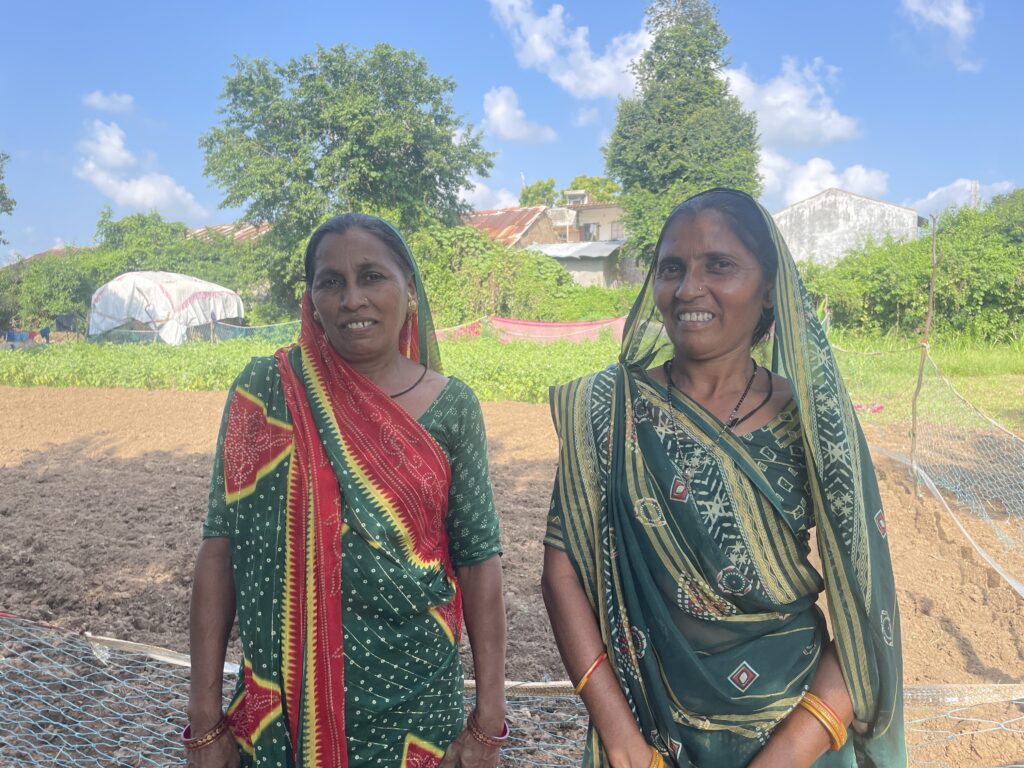
However, not all farmers practising natural farming adopt these methods in entirety. For example, most only switch to using cow dung and urine while continuing with monocropping and climate sensitive high-yield seeds. This, especially when the evidence on the impact of natural farming practices on crop yield is mixed, can make farmers more vulnerable to climate-related crop losses.
In addition to extreme weather events-related crop losses, women farmers that we met said that their crops are routinely destroyed by nilgai and wild boars. Human-wildlife conflicts of this kind are impacting farmers across the country (here and here) and are exacerbated by deforestation and diversion of forest land.
In October last year, we travelled across Gujarat – from the hilly areas of Navsari in south Gujarat and Panchmahals and Mahisagar in eastern Gujarat to the arid regions of Bhavnagar and Rajkot in Saurashtra and Mehsana in north Gujarat. While most farmers we visited in Navsari, Panchmahals and Mahisagar were small subsistence farmers, those in Bhavnagar grew vegetables to be sold and those in Bharuch and Rajkot largely grew cotton with other crops like groundnut and vegetables.
In the first story of our series on gendered challenges women practicing natural farming are facing, we looked at why the government’s focus on cow-centric policies instead of providing science-driven information impacts women farmers. In the second, we looked at how the existing policies do not reach all women farmers, especially those who do not have land and personal networks.
In our concluding story, we look at how women practising natural farming are dealing with climate impacts and the gaps in the existing policies that impede these efforts.
Low Cost, But Labour Intensive
All research has found that natural farming lowers input costs even as there is still a question mark over its impact on yield. The women we met said that losses due to climate impacts hurt them less because natural practices have lowered their input costs.
“We used to spend around Rs 4,000 on chemical fertilisers and pesticides, which we don’t have to anymore,” said Manjulaben, 55, proudly. She quit using chemical fertilisers in her farm in Vedach village nine years ago and leads the self help group that won an award in Bharuch for natural farming practices.
In Sajora, a remote tribal village in Panchmahals’ Ghoghamba block, Champaben Nayak, 51, who once needed 5 kg of urea to fertilise her crops every year has stopped buying it. Married at 12, and widowed by 35, she has been working on her father-in-law’s farm, growing food that feeds the family of five. Two years ago, her name was added as one of the owners of the land.
Switching to natural farming has also saved her money by paying less for water. Because she does not have a borewell, she has to pay a neighbouring farmer Rs 1,200 per hour for water supply. “The organic fertilisers we use keeps the soil moist so I have to use less water for irrigation,” she said.
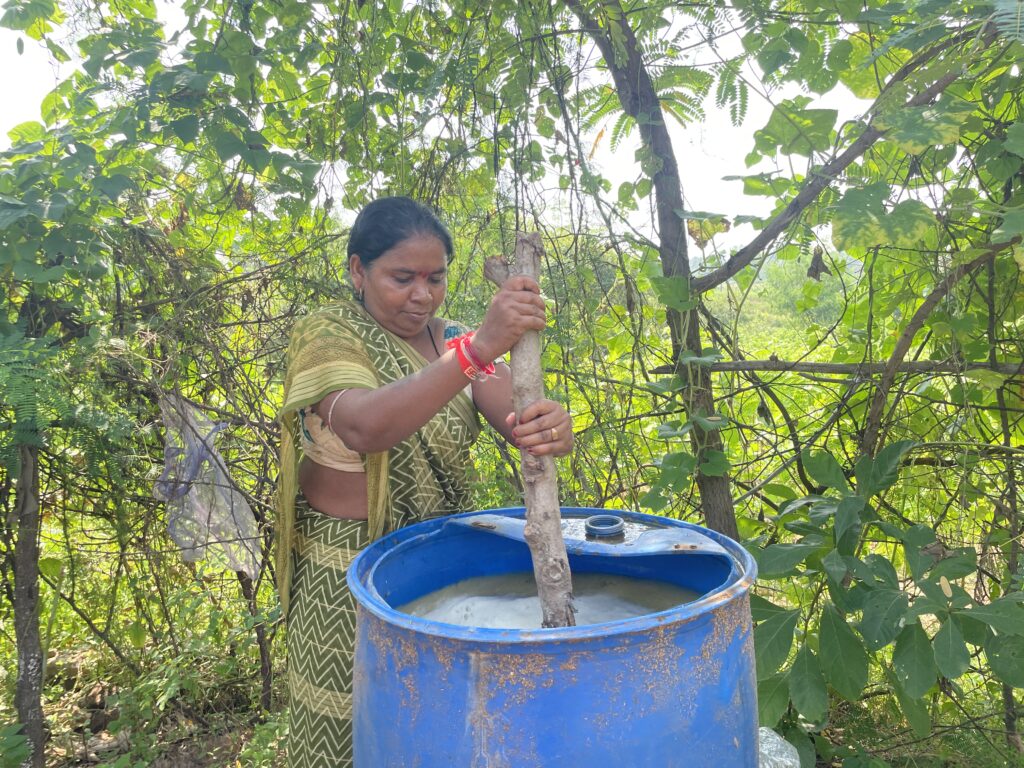
The low input cost is one of the most important factors in promotion and adoption of natural farming, which is often promoted as “Zero Budget Natural Farming”. But this definition excludes the labour and other hidden costs involved.
For each crop in her 0.75 bigha land, Champaben uses four batches – around 800 litres – of jeevamrit. This is labour intensive work because the cow dung and urine have to be collected, mixed into a concoction that has to be stirred twice a day for 15-20 days. The pesticide she makes uses three different kinds of leaves, which have to be collected, ground and mixed urine, soil and jaggery – a task that takes up to two hours.
Almost a 10th of Manjulaben’s 1 acre land is reserved for growing fodder for her two buffaloes. Along with this, she also feeds them what is left after harvesting her bajra (pearl millet) crop. This combination of green and dry fodder ensures she does not have to spend on buying feed for her animals.
But not everyone has the space to grow fodder. Champaben’s land size is around a third of Manjulaben’s, so she spends around Rs 4,000 per year buying fodder.
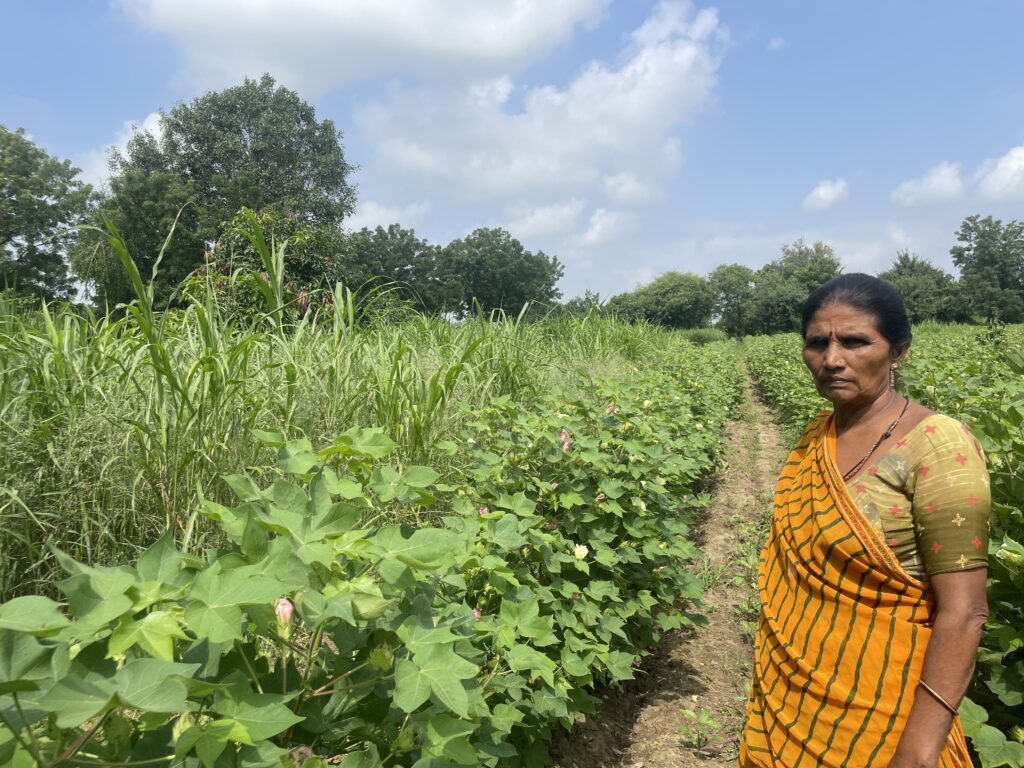
Feeding animals is around 60-70% of the cost of milk production and growing green fodder helps reduce costs. Though she has four cows, Champaben only gets around a litre of milk per day. “I don’t know what price I will get at the dairy for the milk so we just consume it at home,” she said.
Heat stress impacts milk production, disease occurrence, length of lactation and infertility. And lactating dairy animals are more sensitive to heat stress than others. Extreme heat waves will then impact the incomes of dairy farmers.
Those who do not have animals have to buy cow dung and urine to be able to practice natural farming. Kamlaben Gaikwad started practising natural farming in her two acre land in Navsari’s Kamalzari around four years ago but has no cows or buffaloes. “I have to buy three tractors full of cow dung per acre every year,” she said, adding that each tractor load costs her Rs 1,200.
Nilgai, Boar Plunder Crops
Since 2008-09, over 16,000 hectares of forest has been diverted in Gujarat, of which half was in the five years to 2022-23. And there is slow fragmentation of forests in peripheral areas of villages for agriculture. This has resulted in instances of human-animal conflict.
In Bharuch district’s Kahanava village, Dalit farmer Hansaben Maganbhai, 62, has no choice but to lease her two acres of land to tenant farmers after her husband died eight months ago. It takes her more than an hour to walk to her fields and this combined with the routine attacks by animals makes it impossible for her to farm.
“Monkeys and wild boars destroy all our crops so my husband had to stay there overnight. I cannot handle it,” she said. Both of her sons work in companies in Jambusar.
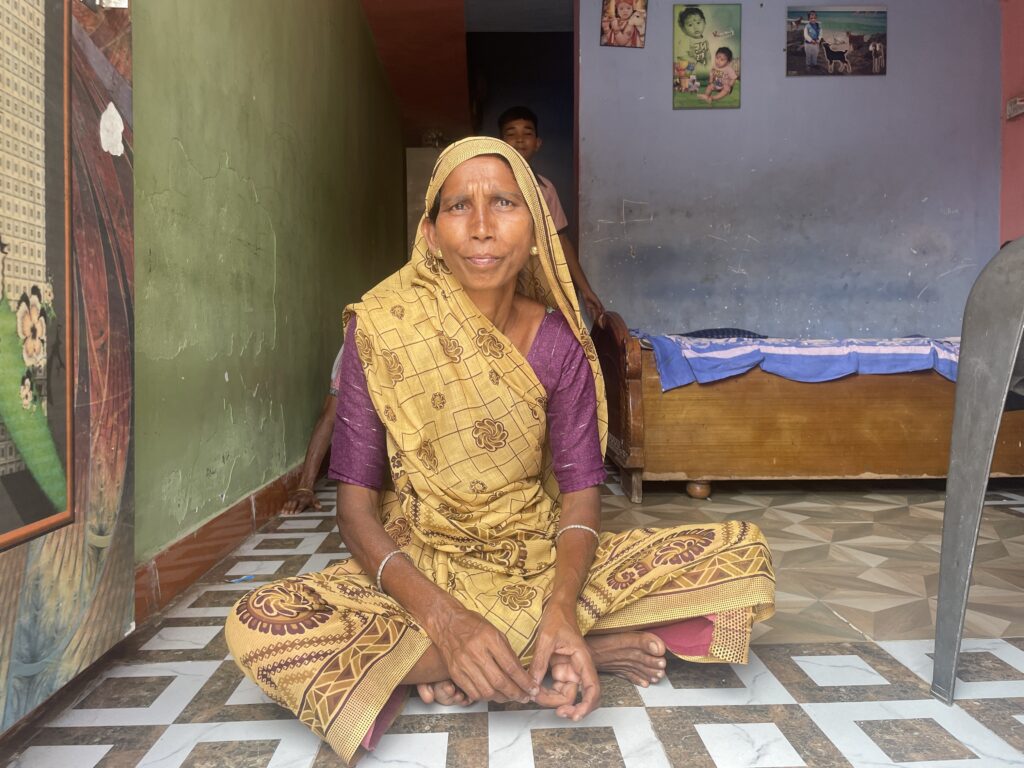
Leasing out the land has severely impacted the financial situation of the family. “My sons’ income of Rs 8-10,000 a month is barely enough for basic needs. I earn Rs 2,000 per month as a sweeper at the government school and another Rs 500 for sweeping around the panchayat office and other common areas in the village,” she said. “We used to grow cotton, pigeon peas and guar gum and earned quite a lot. Now we only get half the share of the earnings.”
In the scenic hilly village of Moylapad in Mahisagar district, surrounded by lakes and forests, nilgai often destroy crops, said Shantaben Sanabhai, 50. “Sometimes, they come and eat the seeds from the ground, right after we finish sowing,” said Kaliben Bariya, 38. All the women we interviewed reported crop attacks by nilgai or wild pigs.
The climate crisis is intensifying such human-wildlife conflicts, which, as we said, is rooted in degradation and fragmentation of the natural habitats of the wildlife. This habitat loss is exacerbated by diversion of forests. Since 2014-15, 1.45 lakh hectares of forest land has been diverted, 62% of it for mining, we had reported in April 2024.
The environment ministry, in December 2024, said that it does not collate data on crop losses due to wild animals, primarily because management of such conflict is the responsibility of state governments.
The Gujarat government runs two different schemes providing support to put up a fence around the farm–one is for wire fencing and the other for solar-powered electric fencing. For wire fencing, the government provides Rs 200 per metre or half of the expense, whichever is less. For solar fencing, the amount is either a lump sum of Rs 15,000 or half of the cost, again the lower amount of the two.
The benefits under the wire fencing scheme can be accessed only once in a lifetime and beneficiaries of this scheme are ineligible for the solar one. To access them, one has to apply through the state government’s i-khedut portal, a repository of information on agricultural schemes, crops, weather and market rates. As we had reported in the previous stories in this series, lack of access to land and information alienates women farmers, especially those from marginalised backgrounds in accessing these schemes.

Of all the women that we interviewed, only Niruben Gadhiya and Hansaben Gadhiya who had over 5 acres of land in Rajkot’s Jasdan block had solar electric fences around their farms. In other areas, women farmers had to find creative solutions to the problem. In Moylapad, women tied sarees around the farm as a fence. “That deters them but doesn’t really stop them,” said Dariyaben.
Alternate Cropping, Indigenous Seeds
This year, Sitaben sowed 4,000 brinjal saplings but all of them were destroyed by the heavy rains. “I had got the farm ploughed and ready but I did not get saplings on time and it rained,” she said. “Then, I had to get the ploughing done once again and laid down these saplings. And it rained again and they got ruined.”
While the brinjal saplings lay dead in a part of her 1.75 acre land in Jambusar, the other half had green cotton plants. “I will now remove these dead saplings and grow castor and bottle gourd,” she said.
What Sitaben practises is a mixed-cropping system where multiple crops are grown on the same land. (In intercropping, different crops are grown together without separate rows for each crop.) Such systems are known to help farmers be resilient to climate impacts, as we said earlier.
But only some of the farmers who practise natural farming do mixed or inter-cropping, found a NITI Aayog-funded study on the impact of natural farming practices on crop yield in Maharashtra, Andhra Pradesh and Karnataka. When the farmers practise monocropping, soil nutrients are exhausted quickly.
Using traditional and indigenous seeds is another core tenet of natural farming. In Kamalzari, Jagrutiben and Sushilaben have been creating a seed bank of traditional variants of paddy and other crops. A room in Sushilaben’s house is filled with large pots of rice that are covered with teak leaves and cow dung. “This stays as is for 2-3 years,” she said. In her scattered 2-acre land, Jagrutiben grows seven variants of rice and many traditional varieties of vegetables, pulses and fruits.
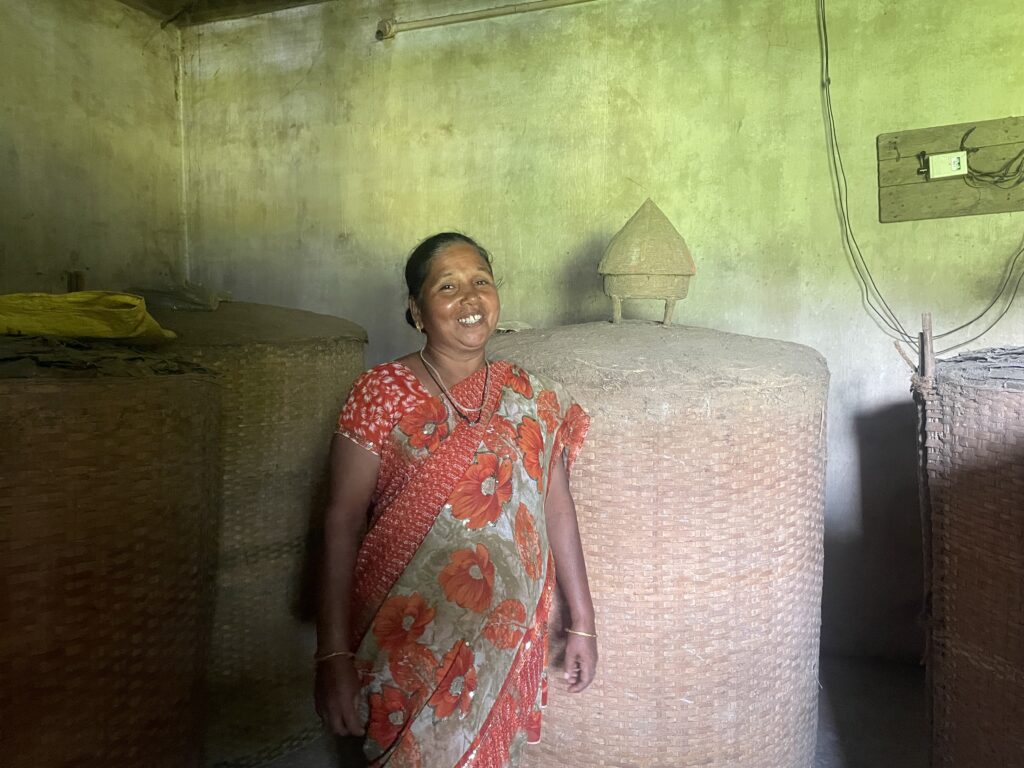
Creating these seed banks can help farmers save money on buying seeds and these traditional varieties are known to be more resilient. But they can also be low in productivity potential and nutrient potential, found a recent report on natural farming by the Indian Council for Research on International Economic Relations (ICRIER) and National Bank for Agriculture and Rural Development (NABARD)
In addition to traditional seeds, agricultural institutes have been researching and developing new climate-resilient varieties. Last August, the government released 109 climate-resilient and bio-fortified varieties of 61 crops that were developed by the Indian Council of Agricultural Research. However, none of the women farmers that we interviewed were aware of such seeds, most used existing high-yield varieties.
Improving access to these seeds is important for their utilisation, found a study conducted in 2016 and 2017 in Bihar, Chhattisgarh, Jharkhand, West Bengal and Odisha. It also found that women farmers more readily adopted these varieties and absorbed the training and information they were given.
We believe everyone deserves equal access to accurate news. Support from our readers enables us to keep our journalism open and free for everyone, all over the world.

